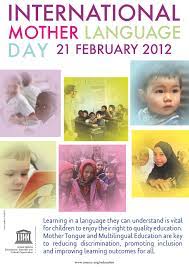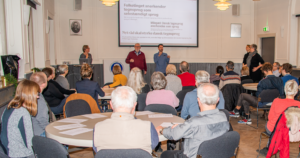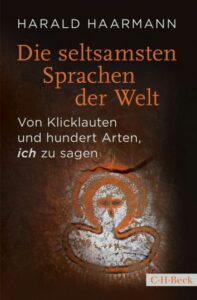International Mother Language Day was celebrated for the first time in 2000 following the 1999 UNESCO initiative. The aim is to preserve cultural and linguistic diversity as well as multilingualism.

According to UNESCO, differences in language and culture must be maintained in order to promote tolerance and respect. Every mother tongue contains unique ways of thinking and expressing itself and provides access to the special culture and traditions of a language community. Every two weeks, a language and its cultural and intellectual heritage disappear, leaving at least 43% of the approx. 6-7000 languages spoken in the world threatened. A similar proportion of people’s known possibilities for structuring their thoughts and their world are thus in danger, and if they disappear, the world becomes culturally poorer.
Multilingualism is a prerequisite for, on the one hand, education in the original mother tongues and, on the other hand, international communication for the benefit of peace, development and sustainability. Approx. 40% of the world’s population does not have access to education in a language they understand, and at the same time early education in the mother tongue is recognized as the basis for multilingualism and thus for democratic participation in the global community.
There are various attempts to find and describe the world’s strangest language. First, a language can display features that are peculiar to our native language that are seen as “normal,” but are objectively not rare. Whether a language is strange by this definition in terms of the viewer’s prior knowledge and perspective. The better one knows a language, the less it is subjectively striking. Second, a language can be “objectively” unusual because it shows rare features. This criterion requires comparing all languages and then determining how rare a feature is. In practice, a subset of all languages is examined, and both this and the linguistic features or categories one chooses to analyze are subjectively selected.
Prof. Dr. Harald Haarmann is a German, internationally renowned linguist who chooses a middle ground between these two perspectives. In the book Die seltsamsten Sprachen der Welt. Von Klicklauten und hundert Arten, ich zu sagen, C. H. Beck 2021, he describes in short, entertaining chapters 49 languages that have marvelous possibilities of expression on various linguistic levels such as sound system, sentence structure, morphology, vocabulary, writing systems, but also languages that take into account the social hierarchy, sacred, totem and taboo languages and artificial languages.
His concern is, in line with UNESCO’s International Mother Language Day, to draw attention to a diversity of human ways of shaping his thoughts, and thus how many different perspectives a number of languages have on the world. Minority languages in particular have an astonishing wealth of direct expression of nuances, which the European majority language can rewrite much, because their grammar only exploits general possibilities in these areas. Fascinatingly, authors refer to linguistic phenomena that exist across a range of language families in vastly different places in the world. The book has fine illustrations, index and source indications.

In Finnish, one can not directly say “no”, Kildin-Sami has 116 consonants, and the isolate Basque, the only one still spoken pre-Roman language in Western Europe, has twelve cases. Vietnamese has six pitches or musical accents that e.g. separates six meanings of the word mai, and in the Somali language there are over two hundred expressions of camels, depending on their characteristics and behavior. These are examples of phenomena that Haarmann analyzes and puts into their cultural contexts.
Some examples among the 49 languages:
The Khoisan languages of southern Africa are special in their clicking sounds (effluxes) and have no written language. The first Khoisan speakers have not come from other areas, so the clicking sounds are humanity’s oldest, still existing language feature, and the neighboring languages have taken over them. The clicking sounds, however, occurred in Damin, an extinct native language in Australia, but only in the ritual language learned exclusively by men, and only in initiation rites. Presumably, Khoikhoi people have emigrated to Australia and have left the clicking sounds as a relic. There are at least four different clicking sounds in all Khoisan languages, formed in different places in the mouth, and some of them are meaning-separating, ie. they have phonemic function. However, a number of Europeans who came as missionaries in the 19th century gave up articulating the clicking sounds and therefore snapped their fingers instead.
Time as an abstract concept does not exist for the Hopi Indians, most of whom live in a reservation in northeastern Arizona. They can express the past using adverbs such as “a long time ago”, “just before” or “still”. But the difference between present and past is not as important to the Hopi Indians as to most other peoples and is therefore not expressed in grammatical categories. On the other hand, the categories “experienced” and “non-experienced” are grammaticalized, i.e. almost similar to our concepts past and present versus future. The unexperienced (forward) time is marked with a particle -ni. Otherwise, our time relationships are expressed using different contexts such as “as long as”, “at that time”, “time measured with a clock”, “favorable opportunity to get something”, “right moment to do something”, “leisure for something”.
Ainu is an isolated language on Japan’s northern island of Hokkaido, i.e. it is not related to any other language. It has the rarest normal word order object-subject-verb (OSV):
Asir cise ci-kar: “we are building a new house” (literally: new house we-make)
This word order occurs in only 17 languages, of which Ainu is the only one in Asia. Moreover, Ainu has no system to inflect the verbs after, but differences in time are expressed solely by means of adverbs (in a similar way as in Hopi). For many generations, Ainu speakers grew up as bilingual with Japanese as a second language, and in 2007 there were only 10 registered people with Ainu as their mother tongue. With the help of a newspaper, a radio program and a hip-hop group, they try to make the Japanese aware of the language and pass it on.
The language Yupik belongs to the Eskimo-Aleut family, which is characterized by polysynthesis, i.e. long constructions consisting of compact word chains (bound morphemes):
tuntussurqatarniksaitengqiggytuq “he had not yet said again that he would hunt reindeer”
(tuntu-ssur-qatar-ni-ksaite-ngqiggyte-uq “pure-hunting-future-say-negation-particle-again-, 3rd person singular indicative”); of the elements in this chain, only the word tuntu “pure” can appear in isolation, while all the other elements are always bound in word chains. Most polysynthetic languages are found in North America, but they also exist in Central America and New Guinea.
Yucagirian is spoken in eastern Siberia and is especially by clearly distinguishing in the form of the verbs between an action which the speaker himself has seen or experienced (direct form of experience), and an account of an action which the speaker can not himself witness, but which he or she has been told by others (indirect form of experience):
Met-ama marqan-n’awn’ikliek pun’mele (past I): “My father killed a polar fox (I have seen it myself)”
Unlike:
Met-ama marqan-n’awn’ikliek pull’elmele (past II): “My father has killed a polar fox (I have been told)”. This feature is also found in other Siberian and East Asian languages and in some Native American languages.
In the Khmer language, i.e. Cambodian, the words for “I” depend on the social status of the speaker and the accused. If the speaker is a monk, “I” is called khnomba:t; in indictment of a monk, “I” is called khnomkaruna. Khnommcah for “I” is used towards the socially superior, especially by women. A submissive (formerly a slave) says khnom “I”; a representative says jen khnom. However, a neutral “I” also exists as khluen khnom. In Dyirbal, an Australian language, there are four different words for “I” depending on who you are with, and there are complicated rules for who can talk to whom, with accompanying paraphrases. Gendered concepts for e.g. “Yes” is also related to the social status of the sexes; women say in khmer cah as opposed to men ba.
In Sumerian, female language is handed down as a social language variant, Emesal, as opposed to the normal language emegir used by men. It can be a contrast between consonants or vowels: igi : i.bi “eye”, nin : shen “lady”, munus : nu.nus “woman”, udu : eze “sheep”, alim : e.lum ” deer” etc. But there are also lexical differences between the normal language and the female language; it applies to strikingly many words from the ritual vocabulary. And there are languages that express family relationships using female ancestry, that is, matrilineal (Crow, Hopi, Basque).
The diverse cultural patterns embedded in the languages show that people’s possibilities for expressing themselves in sound and writing and communicating thoughts are almost limitless. With this wealth of language, each with its own value, we can see the world in new ways and thus be enriched, and with this new agility in perception, we can, as in a mirror, understand ourselves and our own language better.
https://en.unesco.org/observances/mother-language-day
https://en.unesco.org/commemorations
Haarmann, Harald: Die seltsamsten Sprachen der Welt. Von Klicklauten und hundert Arten, ich zu sagen. C.H. Beck 2021

Ulla Weinreich holds a degree in Germanic Philology and Applied Linguistics from the University of Copenhagen, Freie Universität in Berlin and Rijksuniversität in Leiden. Chairman of the Mother Tongue Society (Modersmål-Selskabet), member of the board of representatives of Dansk Sprognævn. Translator from five languages. Publisher of the books Wir sprechen gerne Deutsch (IFB-Verlag 2018) and Sprog på grænsen (with Michael Bach Ipsen, Modersmål-Selskabet 2020).







